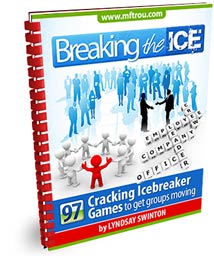Just because you call thirty minutes in a room-full of people and a flip chart a brainstorming activity, doesn’t make it successful. For problem solving brainstorming to be effective, a little bit of coaxing will make all the difference. Here are three brainstorming activities, games and exercises to transform your problem solving sessions.
Brainstorming Activity 1 – Night and Day
Busy people need routines and shortcuts to make it through the day. If we had to consciously think about the steps involved in making a cup of tea, we’d have exhausting our thinking energy before we’d even left the house in the morning. Routine thinking may save time and energy, but seriously hampers creative brainstorming, so use this exercise to challenge traditional thoughts and encourage creativity.
Make a list of common words e.g. night, smart, heavy, quick, apple. Get your team to list the first opposite meaning word that springs to mind e.g. day, stupid, light, slow, pear. This will flush out the obvious, routine words. Challenge your team to come up with at least 3 further opposite words for each word e.g.
Night = day,sun,white,awake, …..
Smart = stupid, scruffy, shabby, in-elegant, clumsy, gawky
You’ll find some similar meaning words creep into your list – that’s fine as these can spark further opposite meaning words. Remember ideas breed ideas and to keep critical, analytical thinking in check. Limit the time spent on this activity to 10-15 minutes, to keep it fresh and focused.
Now it’s time to introduce the “real” brainstorming activity. Write your problem statement clearly and simply, and let those creative minds go to work on generating new and non-routine ideas to solve the problem.
Brainstorming Game 2 – What Can You See?
Sometimes you’re so close to a problem you can’t see how it will ever be solved. This situation is so common, it even has it’s own cliché – “you can’t see the wood for the trees”. Here’s a brainstorming game to help you see things differently, and aid the problem solving process.

Show these shapes to your team, and ask them to individually write down what they can see. You may find descriptions such as; three coloured shapes, or a green circle with a diagonal line, a red hexagon and a yellow thought bubble etc.
Some may have made a small creative leap and seen the top left figure as a green “forbidden” road sign. Others may have taken bigger creative leaps and see a winking, bearded face or an imminent solar eclipse on a cloudy day. It doesn’t matter if you can or can’t see these more outlandish images – there’s no right or wrong answer.
Looking at things in a fresh, new way can trigger a whole train-load of thoughts, and that’s the essence of effective brainstorming.
Get the team to look at the shapes again and see how they describe them differently, second time round.
Now, focus on your problem, and encourage your team to look at it with fresh eyes or “in a different light”. How would they describe the problem to a non-English speaker, a child or a Martian?
Use this process to encourage objectivity and distance from a problem, and start a more creative problem solving process.
Brainstorming Exercise 3 – Who’s Line Is It Anyway?
“Normal” behaviour is encouraged at work, as this is the easiest, most efficient way to get things done. As a result, our creative self often is hidden away, getting flabby from under-use. Then along comes a manager demanding we do some brainstorming to come up with an innovative solution. Ouch! Like un-used muscles, creativity improves with exercise, so here’s a brainstorming exercise to warm-up those under-used creative muscles.
Just like the TV show, the principle of this brainstorming exercise is simple – improvisation. Collect 5 random props from home, the office or from the problem solving team e.g. belt, toy dog, post-it notes, lunch box and paper clip. Leave these props in the middle of the room and encourage people to come up with different uses for the props e.g. the belt could become a Japanese warrior’s head-band or the toy dog is hidden from the group and is “dog-gone”. You get the drift!
Give this exercise a time limit of 10-15 minutes and encourage all team members to take part. Even the shyest will have some creative use for the props!
If you’re aiming to develop a new solution, take your existing product or process and see how you could use it or look at it in a different way. The whackier the better at this stage – remember you’re aiming for quantity not quality – and take note of the ideas generated. It’s only later that we put our critical hats back on, and rate the ideas and assess their suitability.
And that’s only the beginning! These three creative brainstorming activities, games and exercises will get even the most traditional, set thinkers to approach problems differently and come up with creative, innovative solutions or approaches.
